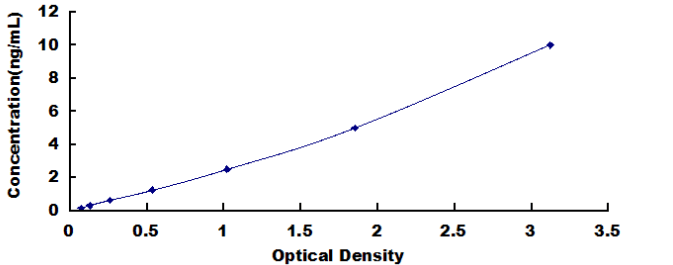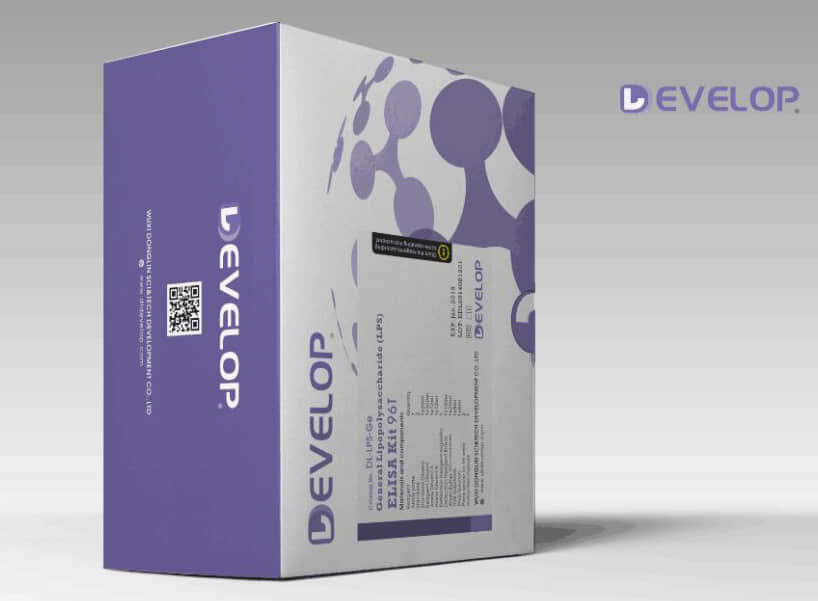Human Tensin 3 (TNS3) ELISA Kit


two product lines: Traditional ELISA Kit and Ready-to-Use ELISA Kit.


Other names:TENS1; TEM6; TPP; Tumor Endothelial Marker 6; Tensin-Like SH2 Domain-Containing 1
Function: May play a role in actin remodeling. Involved in the dissociation of the integrin-tensin-actin complex. EGF activates TNS4 and down-regulates TNS3 which results in capping the tail of ITGB1. Seems to be involved in mammary cell migration. May be involved in cell migration and bone development.
Sequence:
10 20 30 40 50 MEEGHGLDLT YITERIIAVS FPAGCSEESY LHNLQEVTRM LKSKHGDNYL 60 70 80 90 100 VLNLSEKRYD LTKLNPKIMD VGWPELHAPP LDKMCTICKA QESWLNSNLQ 110 120 130 140 150 HVVVIHCRGG KGRIGVVISS YMHFTNVSAS ADQALDRFAM KKFYDDKVSA 160 170 180 190 200 LMQPSQKRYV QFLSGLLSGS VKMNASPLFL HFVILHGTPN FDTGGVCRPF 210 220 230 240 250 LKLYQAMQPV YTSGIYNVGP ENPSRICIVI EPAQLLKGDV MVKCYHKKYR 260 270 280 290 300 SATRDVIFRL QFHTGAVQGY GLVFGKEDLD NASKDDRFPD YGKVELVFSA 310 320 330 340 350 TPEKIQGSEH LYNDHGVIVD YNTTDPLIRW DSYENLSADG EVLHTQGPVD 360 370 380 390 400 GSLYAKVRKK SSSDPGIPGG PQAIPATNSP DHSDHTLSVS SDSGHSTASA 410 420 430 440 450 RTDKTEERLA PGTRRGLSAQ EKAELDQLLS GFGLEDPGSS LKEMTDARSK 460 470 480 490 500 YSGTRHVVPA QVHVNGDAAL KDRETDILDD EMPHHDLHSV DSLGTLSSSE 510 520 530 540 550 GPQSAHLGPF TCHKSSQNSL LSDGFGSNVG EDPQGTLVPD LGLGMDGPYE 560 570 580 590 600 RERTFGSREP KQPQPLLRKP SVSAQMQAYG QSSYSTQTWV RQQQMVVAHQ 610 620 630 640 650 YSFAPDGEAR LVSRCPADNP GLVQAQPRVP LTPTRGTSSR VAVQRGVGSG 660 670 680 690 700 PHPPDTQQPS PSKAFKPRFP GDQVVNGAGP ELSTGPSPGS PTLDIDQSIE 710 720 730 740 750 QLNRLILELD PTFEPIPTHM NALGSQANGS VSPDSVGGGL RASSRLPDTG 760 770 780 790 800 EGPSRATGRQ GSSAEQPLGG RLRKLSLGQY DNDAGGQLPF SKCAWGKAGV 810 820 830 840 850 DYAPNLPPFP SPADVKETMT PGYPQDLDII DGRILSSKES MCSTPAFPVS 860 870 880 890 900 PETPYVKTAL RHPPFSPPEP PLSSPASQHK GGREPRSCPE TLTHAVGMSE 910 920 930 940 950 SPIGPKSTML RADASSTPSF QQAFASSCTI SSNGPGQRRE SSSSAERQWV 960 970 980 990 1000 ESSPKPMVSL LGSGRPTGSP LSAEFSGTRK DSPVLSCFPP SELQAPFHSH 1010 1020 1030 1040 1050 ELSLAEPPDS LAPPSSQAFL GFGTAPVGSG LPPEEDLGAL LANSHGASPT 1060 1070 1080 1090 1100 PSIPLTATGA ADNGFLSHNF LTVAPGHSSH HSPGLQGQGV TLPGQPPLPE 1110 1120 1130 1140 1150 KKRASEGDRS LGSVSPSSSG FSSPHSGSTI SIPFPNVLPD FSKASEAASP 1160 1170 1180 1190 1200 LPDSPGDKLV IVKFVQDTSK FWYKADISRE QAIAMLKDKE PGSFIVRDSH 1210 1220 1230 1240 1250 SFRGAYGLAM KVATPPPSVL QLNKKAGDLA NELVRHFLIE CTPKGVRLKG 1260 1270 1280 1290 1300 CSNEPYFGSL TALVCQHSIT PLALPCKLLI PERDPLEEIA ESSPQTAANS 1310 1320 1330 1340 1350 AAELLKQGAA CNVWYLNSVE MESLTGHQAI QKALSITLVQ EPPPVSTVVH 1360 1370 1380 1390 1400 FKVSAQGITL TDNQRKLFFR RHYPVNSVIF CALDPQDRKW IKDGPSSKVF 1410 1420 1430 1440 GFVARKQGSA TDNVCHLFAE HDPEQPASAI VNFVSKVMIG SPKKV
INTENDED USE
The kit is a sandwich enzyme immunoassay for the in vitro quantitative measurement of TNS3 in human serum, plasma, tissue homogenates or other biological fluids.
DETECTION RANGE
0.156-10ng/mL. The standard curve concentrations used for the ELISA’s were 10ng/mL, 5ng/mL, 2.5ng/mL, 1.25ng/mL, 0.625ng/mL, 0.312ng/mL, 0.156ng/mL.
SENSITIVITY
The minimum detectable dose of TNS3 is typically less than 0.061ng/mL.
The sensitivity of this assay, or Lower Limit of Detection (LLD) was defined as the lowest protein concentration that could be differentiated from zero. It was determined by adding two standard deviations to the mean optical density value of twenty zero standard replicates and calculating the corresponding concentration.
SPECIFICITY
This assay has high sensitivity and excellent specificity for detection of TNS3.
No significant cross-reactivity or interference between TNS3 and analogues was observed.
You can reference link of the kit as following
https://dldevelop.com/Research-reagent/dl-tns3-hu.html
https://www.dldevelop.com/uploadfile/data/DL-TNS3-Hu.pdf
Introduction
| Item | Standard | Test | |
| Description |
The kit is a sandwich enzyme immunoassay for the in vitro quantitative measurement of TNS3 in human serum, plasma, tissue homogenates and other biological fluids. |
Conform | |
| Identification | Colorimetric | Positive | |
| Composition | Traditional ELISA Kit | Ready-to-Use ELISA KIT | Conform |
| Pre-coated, ready to use 96-well strip plate 1 | Pre-coated, ready to use 96-well strip plate 1 | ||
| Plate sealer for 96 wells 2 | Plate sealer for 96 wells 2 | ||
| Standard 2 | Standard 2 | ||
| Diluents buffer 1×45mL | Standard Diluent 1×20mL | ||
| Detection Reagent A 1×120μL | Detection Solution A 1×12mL | ||
| Detection Reagent B 1×120μL | Detection Solution B 1×12mL | ||
| TMB Substrate 1×9mL | TMB Substrate 1×9mL | ||
| Stop Solution 1×6mL | Stop Solution 1×6mL | ||
| Wash Buffer (30 × concentrate) 1×20mL | Wash Buffer (30 × concentrate) 1×20mL | ||
| Instruction manual 1 | Instruction manual 1 | ||
Test principle
The microtiter plate provided in this kit has been pre-coated with an antibody specific to the index. Standards or samples are then added to the appropriate microtiter plate wells with a biotin-conjugated antibody preparation specific to the index. Next, Avidin conjugated to Horseradish Peroxidase (HRP) is added to each microplate well and incubated. After TMB substrate solution is added, only those wells that contain the index, biotin-conjugated antibody and enzyme-conjugated Avidin will exhibit a change in color. The enzyme-substrate reaction is terminated by the addition of sulphuric acid solution and the color change is measured spectrophotometrically at a wavelength of 450nm ± 10nm. The concentration of the index in the samples is then determined by comparing the O.D. of the samples to the standard curve.
Recovery
Matrices listed below were spiked with certain level of recombinant TNS3 and the recovery rates were calculated by comparing the measured value to the expected amount of the index in samples.
| Matrix | Recovery range (%) | Average(%) |
| serum(n=5) | 81-93 | 86 |
| EDTA plasma(n=5) | 80-97 | 88 |
| heparin plasma(n=5) | 90-101 | 95 |
Linearity
The linearity of the kit was assayed by testing samples spiked with appropriate concentration of the index and their serial dilutions. The results were demonstrated by the percentage of calculated concentration to the expected.
| Sample | 1:2 | 1:4 | 1:8 | 1:16 |
| serum(n=5) | 82-96% | 83-98% | 81-99% | 93-101% |
| EDTA plasma(n=5) | 88-101% | 86-95% | 90-102% | 80-93% |
| heparin plasma(n=5) | 80-91% | 82-90% | 95-104% | 79-95% |
Precision
Intra-assay Precision (Precision within an assay): 3 samples with low, middle and high level the index were tested 20 times on one plate, respectively.
Inter-assay Precision (Precision between assays): 3 samples with low, middle and high level the index were tested on 3 different plates, 8 replicates in each plate.
CV(%) = SD/meanX100
Intra-Assay: CV<10%
Inter-Assay: CV<12%
Stability
The stability of ELISA kit is determined by the loss rate of activity. The loss rate of this kit is less than 5% within the expiration date under appropriate storage conditions.
Note:
To minimize unnecessary influences on the performance, operation procedures and lab conditions, especially room temperature, air humidity and incubator temperatures should be strictly regulated. It is also strongly suggested that the whole assay is performed by the same experimenter from the beginning to the end.
Assay procedure summary
1. Prepare all reagents, samples and standards;
2. Add 100µL standard or sample to each well. Incubate 2 hours at 37℃;
3. Aspirate and add 100µL prepared Detection Reagent A. Incubate 1 hour at 37℃;
4. Aspirate and wash 3 times;
5. Add 100µL prepared Detection Reagent B. Incubate 1 hour at 37℃;
6. Aspirate and wash 5 times;
7. Add 90µL Substrate Solution. Incubate 15-25 minutes at 37℃;
8. Add 50µL Stop Solution. Read at 450nm immediately.
Order or get a Quote
We will reply you within 24 hours!














